Bachelor of Creative Technology
Information dossier in support of the application for the New Studies Test
Part C: Related initiatives and resources
Written by:
Dr. Z.M. Ruttkay
Chair of the Creative Technology Programme Development Group
Dr. A. Eliëns
Member of the Creative Technology Programme Development Group
Dr. G.F. van der Hoeven
Creative Technology Programme Educational Director
Version: 2.0
19 November 2008
Faculty of Electrical Engineering, Mathematics and Computer Science
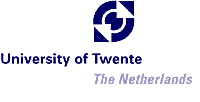
The Information dossier in support of the application for the New Undergraduate Studies Test consists of the following volumes:
Part A: The programme description
The major document, discussing the motivation, the content and formal aspects of the proposed bachelor programme Creative Technology.
References from the text are to be found in the accompanying parts.
Part B: Study units descriptions and staff CVs
A supplementary volume, containing the description for each study unit and the short cv of key academic staff members.
Part C: Related initiatives
A supplementary volume, containing examples, related initiatives, discussion of the implications of the IIP/CREATE (in volume C), references to further resources.
Part D: IIP/CREATE
IIP/CREATE is the abbreviation of The Strategic Research Agenda of the ICT Innovation Platform Creative Industry, published in May, 2008.
Because of its relevance, we add the full document as an appendix. The report is available in digital format from the http://iipcreate.com site, on page:
The present report is available from the Creative Technology wiki page:
http://janus.cs.utwente.nl:8000/twiki/bin/view/CT/WebHome
Acknowledgment
The report is the result of the joint effort of a half-year work of the Creative Technology Programme Committee, defining all aspects of this novel bachelor programme and flashing out study units from different disciplines. The authors acknowledge the contribution of the following people:
Prof.dr.ir. J. van Amerongen (EWI)
Dr.ir. G.M. Bonnema (CTW)
Ir. W. Eggink (CTW)
Prof.dr.ir. B.J. Geurts (EWI)
Dr. A.H. Mader (EWI)
Ir. J. Scholten (EWI)
Bas Olde Hampsink (Saxion Hogescholen, Academie Toegepaste kunst en techniek) acted as an appreciated external advisor of the working group.
Finally, we are indebted for the support and advice from several colleagues at EWI and at other faculties, as well as from outside the UT, particularly from ArtEZ AKI (ArtEZ AKI, The Enschede Academy of Visual Arts); TU/e (Eindhoven), HvK (Utrecht), V2_ (Rotterdam) and the Waag Society (Amsterdam).
Summary
This report proposes a new three year university bachelor programme Creative Technology to be offered by the University of Twente.
The Faculty of Electrical Engineering, Mathematics and Computer Science of the university will be responsible for the programme, but other faculties, notably the faculties of Engineering Technology and Behavioural Sciences are involved in programme development and teaching.
General motivation for this proposal is found in the development of ICT and its impact on the job market and the national ICT strategy in relation to the creative industry.
Another and equally important motivation is the need to attract more students (in particular also female students) to technology and engineering, and to educate a type of engineer who is interested, competent and skilled in both artistic and scientific domains, motivated to invent new (technological) devices for the well-being of people, and driven by curiosity and the joy of the process of creation itself.
The Strategic Research Agenda of the ICT Innovation Platform Creative Industry, published in May, 2008, comparison with other educational programmes in the same or an adjacent field, and an analysis of professional scenarios for people with a Creative Technology degree underpin domain specific requirements for this university (WO) bachelor programme.
The programme has four major components: Technology, Creativity, Design and Business. Technology covers the basics of Mathematics and Computer Science, as well as the themes New Media and Smart Technology (including the basics of Electrical Engineering). Students make a choice between the two themes as a track of specialisation.
In the instructional concept the stimulus for creativity in study units Creative Applications and Creative Explorations is central. Students will build their portfolio, and are encouraged to start companies. The programme is a mixture of disciplinary courses and project-based study units. The study load of the entire programme is 180 EC (in both tracks).
Students with any VWO profile may be enrolled. The intake procedure is elaborate. Every potential student who applies is thoroughly screened and receives an individual advice about the chances of success. This approach is chosen to meet the challenge of attracting more students and to educate the “new” type of engineer as envisioned by the programme. The quality of this education will gain from the presence of students with all kinds of backgrounds.
An intake of at least 60 students per year is expected. Market research shows an even higher potential.
The university and the faculty have awarded considerable budgets to support this initiative. Plans to create appropriate facilities for the programme are in the initial phases of execution. Part of the budget is used to strengthen the university’s design group (in cooperation with Industrial Engineering), and to help lecturers prepare for the new tasks this programme sets.
There is outside support for the initiative. The dean of the faculty has an advisory board of representatives from industry and other universities, which assists in all matters concerning the programme: defining the goals, thinking about the instructional concept and core content, finding guest lecturers for subjects and so on.
TABLE OF CONTENTS
1 EXAMPLES OF CREATIVE TECHNOLOGY APPLICATIONS 7
1.1 Darfur is Dying, University of Southern California 7
1.2 Exchange Cabinet, Waag Society, Amsterdam 7
1.6 Audiovox.s Digital Message Center 9
2 INTERNATIONAL EDUCATIONAL EXAMPLES 11
2.1 School of Creative Technologies, University of Portsmouth 11
2.3 Culture Lab, Newcastle University 12
2.4 Digital Arts & Entertainment, HOWEST, Kortrijk, Belgium 12
2.5 School of Interactive Arts + Technologies, Simon Fraser University, Canada 12
2.6 KEIO Media Design, Keio University Japan 12
2.7 The Media Lab, MIT, Boston, USA 13
2.8 Mathematics across the curriculum at Dartmouth University 13
3 EDUCATIONAL INITIATIVES IN THE NETHERLANDS 13
3.1 Industrial Design, Technische Universiteit, Eindhoven 13
3.2 Human Ambience BSc, VU Amsterdam 13
3.3 Information, Multimedia and Management BSc, VU Amsterdam 14
3.4 Media Technology MSc, Leiden University 15
3.6 New Media MSc, Universiteit van Amsterdam 15
3.7 QANTM College Amsterdam: Bachelor Education in 3D, Game Design and Game Development 15
4 NATIONAL INITIATIVES IN THE PUBLIC SECTOR 16
4.1 Waag Society, Amsterdam 16
4.4 Mediamatic.net, Amsterdam 17
URL: HTTP://WWW.MEDIAMATIC.NET 17
4.5 Mediamatic Lab, Amsterdam 17
4.6 Creative Cities Amsterdam Area 17
5 INITIATIVES IN THE TWENTE REGION 18
5.1 planetart, Enschede, Amsterdam 18
5.2 de creative fabriek, Hengelo 18
6 EXPERTS FROM BRANDING UT STUDY [NEWCOM06] 19
6.1 On the different aspects influencing the choice of university by VWO students 19
6.2 On the profile of VWO pupils, and the gender differences 19
8 BEING HUMAN – COMPUTER INTERACTION IN THE YEAR 2020 22
8.1 Mission statement & summary 22
9 THE IIP CREATE SCIENTIFIC RESEARCH AGENDA 26
9.2 The Strategic Agenda Revisited – implications for Creative Technology 27
10.2.1 Learning material and tutorials 32
10.2.2 Inspiring examples of media art 32
10.2.3 Resources for smart systems 33
10.2.4 Events, creative business, research and technology 33
10.2.5 Institutions and sources of information 33
1Examples of Creative Technology Applications
1.1Darfur is Dying, University of Southern California
url: http://www.darfurisdying.com/aboutgame.html
From the website: In partnership with the Reebok Human Rights Foundation and the International Cris Group, mtvU launched the Darfur Digital Activist Contest, un unprecedented competition bringing together student technology and activism to help stop the genocide in Darfur. Susana Ruiz, Ashley Yor, Mike Stein, Noah Keating and Kelle Santiago of the University of Southern California conceived the game and worked closely with humanitarian aid workers with extensive on the ground experience in Darfur to develop it.
Darfur is Dying is a narrative-based simulation where the user, from the perspective of the displaced Darfurian, negotiates forces that threaten the survival of his or her refugee camp. It offers a faint glimpse of what it’s like for the more than 2.5 million who have been internally displaced by the crisis in Sudan.
1.2Exchange Cabinet, Waag Society, Amsterdam
url: http://www.waag.org/project/wisselkabinet
This very successful project at the Waag Society was the realization of a Dutch student’s idea. The cabinet is designed as an inviting object, hosting scanning, recording and communication facilities designed to be used by elderly people. They are to record and share their memories, in the form of cross-modal stories. The installation has been in use in a retired people’s home. It combines the function of communication device, source of learning and entertainment, and indirectly, improves the mental and emotional state of the elderly, providing a ‘remedy’ for loneliness. Besides, the idea is realized in a more rich business context, as a Dutch historic archive has been brought in as a client for the images and stories of the elderly. From a technological point of view, the project required state of the art video and audio representation and communication, multimedia DB management, internet protocols, man-machine interaction design and system integration, as well as ethical and juridical issues.
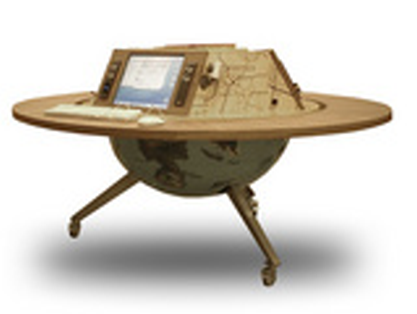

1.3Reactable
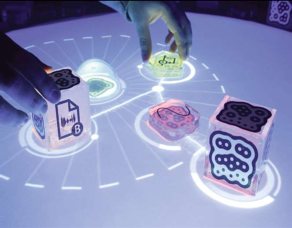
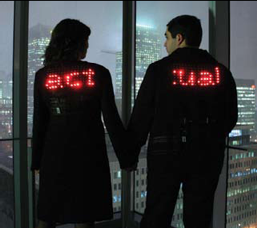
The Reactable: a multitouch interface for playing music. Performers can simultaneously interact with it by moving and rotating physical objects on its surface. Reactable was developed by Sergi Jordà and colleagues at the Universitat Pompeu Fabra, Barcelona. Icelandic songstress Bjork used one on her 2007 tour. [Human08, p. 16]
1.4Animated Textiles
Animated Textiles developed by Studio subTela at the Hexagram Institute, Montreal, Canada. These two jackets synch up when the wearers hold hands, and the message scrolls from the back of one person to the other. [Human08, p. 18]
1.5Rovio robotic webcam
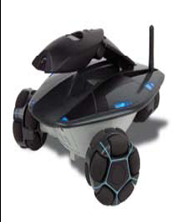
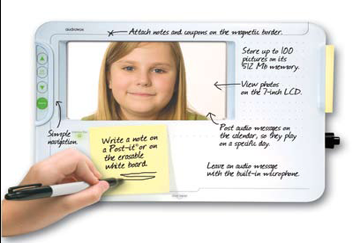
The Rovio robotic webcam is wirelessly connected to the Internet. It roams around the home providing an audio and video link to keep an eye on family or pets when you are out. [Human08, p. 21]
1.6Audiovox.s Digital Message Center
Audiovox.s Digital Message Center is designed to be attached to the refrigerator, letting families scribble digital notes and leave audio and video messages for each other. [Human08, p. 27]
1.7Duality
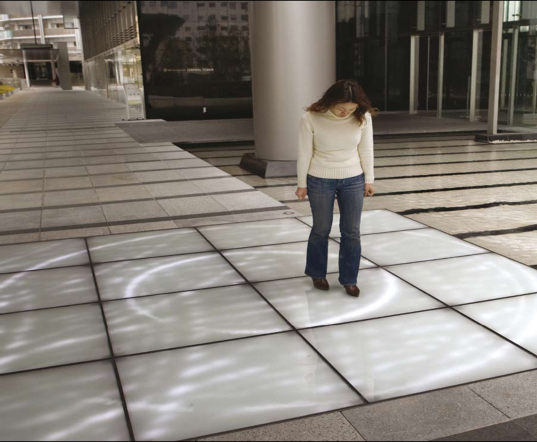
ART+COM.s artistic installation called Duality, located at the exit of a metro station in Tokyo. Passers-by provoke virtual ripple effects with their footsteps, as if walking across a pond. [Human08, p. 32]
2International educational examples
2.1School of Creative Technologies, University of Portsmouth
url:
" http://www.port.ac.uk/departments/academic/ct
The current department is a result of a 7-year development, with a staff highly dedicated to education, including prominent people from industry. About their mission:
“The sphere of activity of Creative Technologies is in those areas where new technology is impacting in the Arts, Leisure and Entertainment. It specializes in subjects like web design, graphics, animation, virtual reality, video, audio and music.
These are areas that will continue to grow and move forward at an alarming rate: Creative Technologies intends to be at the forefront of this wave!”
Undergraduate education programs by the CT Faculty:
•Computer Animation - BSc (Hons)
•Computer Games Technology - BSc (Hons)
•Creative And Cultural Entrepreneurship - BA (Hons)
•Creative Computing Technologies - BSc (Hons)
•Creative Technologies And Enterprise - FdSc
•Digital Media - BSc (Hons)
•Digital Video Technologies - BSc (Hons)
•Enterprise In Computer Games Technology - BSc (Hons)
•Enterprise In Entertainment Technology - BSc (Hons)
•Entertainment Technology - BSc (Hons)
•Multimedia Programming - BSc (Hons)
•Music And Sound Technology - BSc (Hons)
2.2Creative & Cultural Industries, Faculty of Arts, Humanities & Social Sciences, University of Lancashire
url: http://www.uclan.ac.uk/facs/class/humanities/creatind/index.htm
Creative and Cultural Industries is an exciting new three year B.A. (Bachelor of Arts) degree programme to be offered by the University of Central Lancashire from September 2007, and is one of the first of its kind anywhere in the UK.
It seeks to equip students with both the theoretical knowledge which enriches their thinking and develops their ideas, as well as the practical skills which they need to master in order to thrive in this competitive, but richly rewarding sector. While drawing on the wide range of academic skills and expertise available across many Departments and Faculties at UCLAN, this degree programme will also utilise an extensive and growing network of contacts in the creative industries, to provide workshops, training and adequate first hand exposure to industry, along with modules on how to set up their own company, all during the three year curriculum. Audio Visual Media, Fashion, Sonic Arts, Graphic Design and Games Design are just some of the industrial options that this comprehensive programme will cover.
2.3Culture Lab, Newcastle University
url: http://www.ncl.ac.uk/culturelab
Culture Lab is a unique research infrastructure providing an environment for academics and practitioners working beyond traditional disciplinary boundaries.
We promote socially and economically valuable synergies with artists, creative industries, and cultural and scientific institutions, and the development of innovative research with digital tools.
2.4Digital Arts & Entertainment, HOWEST, Kortrijk, Belgium
url: http://www.digitalartsandentertainment.com/#/nl/curriculum
The DAE curriculum is a three year bachelor, based on the requirements for creating interactive 3D environments. The curriculum offers a mix of artistic 3D skills and competences on the one hand, and programming technical skills and competences on the other hand.
2.5School of Interactive Arts + Technologies, Simon Fraser University, Canada
url: http://www.siat.sfu.ca/core-ideas
The School of Interactive Arts + Technology (SIAT) is a future-focused school where technologists, artists, designers and theorists thrive in collaborative research, invention and theoretical thinking.
SIAT fosters dialogue and shared work around the core idea of creating better human experiences through design, interactivity, art and technology. Its program, faculty and facilities enable students to develop themselves as researchers; to learn new knowledge, expertise and skills; and to address critical issues of technology in society.
In SIAT, we are engaging in and transforming the world to a place where technology, design, art, and media serve people. A world where we better understand how interactive technologies transform the human experience in expected and unexpected ways: A world where we can design new technologies to support humans to think, feel, communicate, and connect.
2.6KEIO Media Design, Keio University Japan
url: http://www.kmd.keio.ac.jp/en
Keio University Graduate School of Media Design is committed to fostering "Media Innovators" and creative global leaders who understand the core creative skills of design, technology, management, and policy in the field of media design. Education will take a practical, hands-on, and global approach to offering various projects grounded in practice by collaborating with international partner institutions and research facilities.
Keio University Graduate School of Media Design provides a premier graduate education to prepare students for leadership as "Media Innovators" in the modern creative society. A "Media Innovator" is a leader who understands the core values of creativity and innovation, who can implement and manage creative activities, and who is also capable of converting creative and innovative activities into economic and cultural value for society to the maximum extent. Therefore, the education program produces international professional leaders and scholars who can revolutionize industry and the bureaucracy, create and innovate new generations of digital media, who can produce innovative digital content and experience, and who can create, edit, and distribute "knowledge", which is the most valuable resource in our global society.
2.7The Media Lab, MIT, Boston, USA
url: http://www.media.mit.edu/
At the Media Lab, the future is lived, not imagined. In a world where radical technology advances are taken for granted, we design technology for people to create a better future.
The Lab comprises rigorous research and graduate degree programs, where traditional disciplines get checked at the door. Future-obsessed product designers, nanotechnologists, data-visualization experts, industry researchers, and pioneers of computer interfaces work side by side to tirelessly invent–and reinvent–how humans experience, and can be aided by, technology.
2.8Mathematics across the curriculum at Dartmouth University
url: http://www.math.dartmouth.edu/~matc/
Two of the major objectives of this successful past project:
1. Motivate students to take mathematics seriously
We believe we need to change the way mathematics seems to put off budding scientists and social scientists so that they attempt to minimize their use of it throughout their undergraduate career and (one suspects) later in life. An interdisciplinary approach to mathematics, allowing students to focus on their discipline, should prove a motivator to do otherwise.
2. Broaden the diversity of those undergraduates enrolling in math or science courses
In addition to ethnic diversity this project is designed to reach out to students in the humanities and fine arts with courses and materials highlighting the mathematics that intersects their current interests. The presence of these people in mathematics courses will make those courses richer for those inclined more toward the mathematics and science and will make the mathematics important and beautiful to those not initially drawn to it.
3Educational initiatives in the Netherlands
3.1Industrial Design, Technische Universiteit, Eindhoven
url: http://w3.id.tue.nl/en/information_and_recruitment_activities/
The Industrial Design course started in 2001 and counts a number of nationalities among its multidisciplinary staff. The emphasis is on ‘ambient intelligence’: the design of intelligent products, systems, and services. Over the next couple of years 'ambient care' will receive special attention because health and well-being are among the primary focal areas of both Industrial Design and the TU/e. Because of its broad range of contacts with companies and institutions in Europe and beyond (Singapore, Australia, the United States), Industrial Design is well-equipped to respond to international developments in a pro-active manner.
The most noteworthy characteristics of Industrial Design at the TU/e are its unique educational system, the intensive coaching students receive, the focus on practice-oriented teaching and learning, and the close collaboration with local, national, and international companies and institutions. Self-supporting, responsible students who are creative and have an interest in people will find their way at Industrial Design. Motivation and involvement are important assets, as the Industrial Design Bachelor is a demanding program that often requires more than a day’s work...
3.2Human Ambience BSc, VU Amsterdam
url: www.cs.vu.nl/~treur/HumanAmbience/HAtekst.htm
Human Ambience is a new, multidisciplinary, problem-oriented curriculum with a strong focus on human function, in a physical, psychological as well as social context. ... Students are encouraged to analyse problems and find solutions making use of modern technologies, with as an ultimate goal to create an understanding, more human environment. As examples of such solutions are mentioned: the caring wristband, for monitoring immediate health problems, and the attentive medicine box, which alerts the user when it is time to take medicines.
3.3Information, Multimedia and Management BSc, VU Amsterdam
url: www.few.vu.nl/aanstaande_studenten/bachelors/Informatiekunde/page_ik_intro.html
According to the website, the IMM curriculum (Information, Multimedia and Management) bridges the gap between information and communication-technology (ICT) and the application of these technologies in business and society. The IMM graduate will act as an intermediary between ICT-designers and the people that work with ICT. During the study the student will build an understanding of how non-technical users and organisation perceive information and computers, and they will learn how to deploy this knowledge to improve the way people work with current-day information systems.
3.4Media Technology MSc, Leiden University
url: http://mediatechnology.leiden.edu
The Media Technology MSc programme is a place where students are encouraged to formulate their own scientific questions, and to translate personal inspirations and curiosities into their own research projects. To answer these questions, students create actual products, because we are convinced that by doing and creating, new scientific insights into the underlying question are encountered.
The programme is a joint initiative of Leiden University’s computer science institute (LIACS) and the Faculty of Creative and Performing Arts
The programme recognizes creativity as an important factor in scientific innovation. It aims to be a place where students, artists and scientists do research by creating innovative solutions, inspired by results and principles of science. To achieve this, the curriculum focuses on creative exploration and on the understanding of science and technology. The programme encourages its students to draw from the knowledge available throughout Leiden University and the ArtScience programme of the Royal Academy of Arts in The Hague.
3.5Game Studies, Utrecht
url: http://www.upgear.nl/?pid=16
In Utrecht there is a variety of studies offering courses in new media and game development, either as the core of the studies, or as a minor in a related field:
HKU: Game Design & Development
HKU: Design for Virtual Theatre & Games
HU: Bachelor Media technology with end profile Game Technology
UU: Information Science with minor game- and media technology
UU: MSc Game and Media Technology
where HKU stands for Hogeschool Kunsten Utrecht, HU for Hogeschool Utrecht and UU for University of Utrecht. Note that the last variant, Minor New Media & Digital Culture, is offered by the Faculteit Letteren.
3.6New Media MSc, Universiteit van Amsterdam
url: http://www.studeren.uva.nl/ma_new_media
The international Master in New Media & Digital Culture is for students interested in contributing to timely discourse surrounding critical media theory. It builds upon the pioneering new media scene that Amsterdam is known for, with an emphasis on the study of Internet culture. Students gain an in-depth knowledge in new media theory, viewed from the perspectives of media archaeological, materialist and other critical traditions, and applied to such topics as bogging, locative media, networks and protocol. Additionally students may be trained in the areas of info-aesthetics and visualization, with its emphasis on how to read, understand and critique information graphics, interfaces as well as online interactivity. Among the expertise available to students is the emerging area of digital methods --Internet research approaches and techniques that are specific to the new medium and the study of natively digital objects.
3.7QANTM College Amsterdam: Bachelor Education in 3D, Game Design and Game Development
url: http://www.qantm.nl
The Quantum college offers:
Bachelor of Science in Games Programming
Bachelor of Arts in Interactive Animation
The website informs us that: As of 2008 we are validated by the Middlesex University in London to offer Bachelor Degrees (BA and BSc) for the education in game design and development.
4National initiatives in the public sector
4.1Waag Society, Amsterdam
url: http://waag.org/pagina/waagsociety
Waag Society is the name of what started in 1994 as 'Society for old and new Media', Foundation de Waag. Founders were Caroline Nevejan and Marleen Stikker, who is still Waag Society's director.
The Society's -soon to be called 'Waag Society'- mission was to make new media available for groups of people that have little access to computers and internet, thus increasing their quality of living. After a complete restoration of the Waag building, a small group of enthusiastic idealists began their activities in 1996.
The media lab developed into an avant-gardistic think tank with a lot of freedom. But with an eye for commercial possibilities: attempts were made to bring Waag prototypes to the market. Waag Society grew into an institution that was active in the fields of networked art, healthcare, education and internet related issues like bandwidth and copyright.
The international network became increasingly important: Waag Society has a worldwide network with partners in countries like India, Canada and the UK.
Nowadays, Waag Society is an acknowledged institute where apart from R & D, there is room for experiment with new technologies, art and culture. Partners come from all parts of society: universities but also companies work together in our projects. Waag Society is a foundation and as such a non-profit organisation.
4.2Media Guild, Amsterdam
url: http://mediaguild.com/organisation
from the website: Media Guild is a not for profit organization that fosters innovation and brings it to the market and to society. Media Guild has two important goals that follow naturally from each other.
To support innovative starters in the creative industry
To bring businesses and knowledge institutes in touch with the creative industry and innovation
Innovative starters:
Everybody who is talented and has a good (interactive media) idea can be considered for a place at Media Guild. All you need is an entrepreneurial character and an excellent innovative idea that can potentially reach the market.
4.3V2_, Rotterdam
url: http://www.v2.nl
from the website: V2_, Institute for the Unstable Media, is an interdisciplinary centre for art and media technology in Rotterdam (the Netherlands). In 25 years, V2_ has become an international organization for experimentation, research and development in art and media technology. V2_'s activities include organizing presentations, exhibitions and workshops, research and development of artworks in its own media lab, publishing in the field of art and media technology, and developing an online archive.
4.4Mediamatic.net, Amsterdam
url: http://www.mediamatic.net
from the website: New Media, Art, Society
Mediamatic is a cultural organization in Amsterdam. We do exhibitions, presentations, workshops and much more. This site combines an overview with news and theory. This site is also a social network of people interested and involved in our activities. The Mediamatic organisation is closely related to the Mediamatic Lab, see below.
4.5Mediamatic Lab, Amsterdam
Mediamatic Lab develops and builds intelligent, innovative media-applications. We have specialised in supporting networks of people and in knowledge exchange. We build websites and other new media applications. For our cultural activities visit Stichting Mediamatic our sister organisation.
4.6Creative Cities Amsterdam Area
url: http://www.ccaa.nl/
Creative Cities Amsterdam Area (CCAA), is a consortium created to stimulate entrepreneurs in the respective cities of Amsterdam Utrecht Almere Haarlem Zaanstad Amersfoort Hilversum, and more in particular provides facilities to stimulate the growth of the creative industry in these cities.
The CCAA site also functions as an information portal announcing, for example, funding opportunities for Digital Pioneers, the foundation of a Creative Campus in Almere and a national Creativity Contest.
5Initiatives in the Twente region
5.1planetart, Enschede, Amsterdam
contacts: Kees de Groot (creative director), Viola van Alphen (managing director)
Planetart organizes festivals and events, also in the local Twente context, often in cooperation with students from universities, as for example in the recent KunstVlaai:
http://www.planetart.nl/kunstvlaai.htm
Initial contacts have been established for possible cooperation in the future.
5.2de creative fabriek, Hengelo
url: http://www.creatievefabriek.nl/
contact(s): Sonja Warbroek (festivals en jeugd), Kees de Groot (Art Director en Ateliergroepen)
from the website: The Creative Factory aims on the one hand at a creative and sustainable re-development of (Twente) industrial heritage, and on the other hand to activate and stimulate the creative economy of Twente, by clustering mutually reinforcing companies, knowledge institutes, cultural organisations, artists, craftsmen and innovative entrepreneurs.
Initial contacts have been established for possible cooperation in the future.
5.3syntens, Twente
url: http://www.syntens.nl/SYNTENS/Projecten/Innovatieprojecten
contact(s): Marco Strijks, Harry Bosch
From the website: Syntens, Innovation Network supports both regional and national innovation projects, by
•acting as a mediator between companies and organisations,
•organising workshops about hot topics,
•transferring knowledge from universities and higher education
•financial support for research and development
Syntens (Twente) is also involved in the TOP-arrangement, which helps students to become entrepreneurs, and contacts have been established for possible cooperation in the future
6Experts from Branding UT study [NEWCOM06]
6.1On the different aspects influencing the choice of university by VWO students
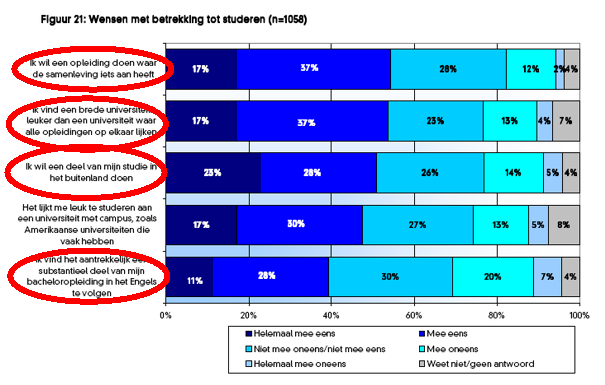

6.2On the profile of VWO pupils, and the gender differences
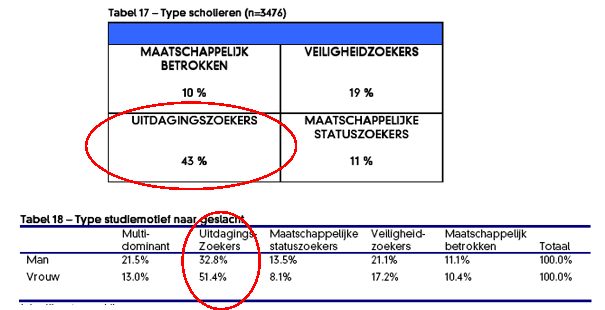

7Professional Scenario(s)
As an indication of possible professional roles, after obtaining the bachelor creative technology, we will briefly sketch the following scenarios:
•creative industry -- in new entrepreneurial activities
•product design -- in healthcare and entertainment
•communication -- regional/global media campaign
•entertainment -- new concepts in private and public settings
•game development -- serious games in education and corporate training
creative industry
The creative industry is a somewhat wide notion, originally introduced by the Blair government to re-vitalize dormant industrial areas. After the success of Silicon Valley, and New York's Silicon Alley, the model was adopted by among others Amsterdam and Berlin. In the creative industries, our students might take any of the following roles:
•entrepreneur -- creating business
•creative genius -- generating idea(s)
•content author -- to produce material(s)
•technical developer -- to write script(s) & program(s)
Despite the wide range of possible roles, whatever role is taken, however, our graduates will distinguish themselves by their level of technical expertise.
product design
In an ever-growing consumer market, product design will be an area of active development. Dependent on the context of deployment, healthcare, entertainment, or home or office furniture, our students may be active in any of the following roles:
•visual design -- to give aesthetic appeal
•concept development -- to accommodate human needs
•usability & deployment -- making it fit for it's role
•evangelist -- to promote the (benefits of the) idea
Despite the wide range of possible roles, whatever role is taken, however, our graduates will distinguish themselves by their level of technical expertise.
communication
Traditional communication models, in broadcasting and advertisement, are gradually being replaced by multimedia strategies, involving the internet and cross media in an essential way. In such media endeavours we may find our students active in one of the following roles or departments:
•web developer -- setting up portal(s)
•crossmedia architect -- relating all media
•production agency -- to coordinate delivery
•strategic planning -- defining targets and goals
Despite the wide range of possible roles, whatever role is taken, however, our graduates will distinguish themselves by their level of technical expertise.
entertainment
Entertainment is an everlasting source of revenue for innovative enterprises. In our society the technical opportunities for entertainment are abundant, both in an urban and private setting. Our students may work in the area of entertainment in one of the following roles or fields:
•concept design -- defining new artefacts
•technical infrastructure -- for realization
•business plan -- to coordinate the enterprise
•production manager -- mediating between parties
Despite the wide range of possible roles, whatever role is taken, however, our graduates will distinguish themselves by their level of technical expertise.
scenario -- game development
Games are increasingly being recognized as valuable tools in an educational environment, and corporate learning. With the growing attention for serious games, it becomes likely that we will find our students active in game development, in either one of the following roles or activities:
•theme(s) & storyline(s) -- setting the context
•style & visual(s) -- creating the appeal
•asset development -- to embody the game
•interaction & experience design -- to promote involvement
Despite the wide range of possible roles, whatever role is taken, however, our graduates will distinguish themselves by their level of technical expertise.
8Being Human – Computer Interaction in the year 2020
In the following we present a summary as well as additional quotes with examples of the report [Human08]:
BEING HUMAN HUMAN-COMPUTER INTERACTION IN THE YEAR 2020 Edited by Richard Harper, Tom Rodden, Yvonne Rogers and Abigail Sellen. The full text is available from:
http://research.microsoft.com/hci2020
8.1Mission statement & summary
Computer technologies are not neutral, they are loaded with human, cultural and social values. We need to define a new agenda for human-computer interaction in the 21st century, one that anticipates and shapes the impact of technology rather than simply reacts to it.
Our Changing World
Computers have played a massive role in changing the way we live over the last couple of decades. They are no longer possessions of the privileged but are rapidly becoming inexpensive, everyday commodities. They have evolved from being isolated machines to globally interconnected devices. Not only has access to computers vastly increased, but the ways we interact with them and materials used for computer devices have changed too. All of this means that computers can now be interwoven with almost every aspect of our lives. As we move towards 2020, so the extent of these changes will increase. By 2020, it may not be possible to realize all of our goals, ambitions and aspirations without using a computer or computing in one way or another. This binding of computing to our daily activities will in turn affect our values, goals and aspirations.
Transformations in Interaction
There are five main ways in which our interactions with computers will be transformed as we approach 2020. How we define and think about our relationships with computers is radically changing. How we use them and rely on them is also being transformed. At the same time, we are becoming hyper connected and our actions, conversations and interactions are being increasingly etched into our digital landscapes. There is more scope than ever before to solve hard problems and allow new forms of engagement and creativity. We have begun to raise the issues and concerns that these transformations provoke. There are many new kinds of questions we have not had to be concerned with before. Some will be within the remit of Human-Computer Interaction to address and others will not.
HCI: Looking Forward
HCI needs to move forward from concerns about the production and processing of information toward the design and evaluation of systems that enable human values to be achieved. Doing so requires HCI to shift its epistemological constraints away from their psychological roots towards other approaches, such as the philosophical, where conceptual sensitivity to meaning, purpose, and desire is possible. This suggests adding a fifth stage to HCI’s conventional design/research model: a stage of conceptual analysis where we consider the human values we are trying to support or research. This affects the whole cycle of research and design, including how we understand the user, how we do studies in the field and the laboratory, how we reflect on the values sought in design, how we build prototypes and how we evaluate our designs. Finally, HCI researchers need a larger assembly of skills and know-how if they are to succeed, which has implications for the concepts, frameworks and theories of HCI.
Recommendations
1.Revisit research and design methods in HCI
2.Be explicit about the remit of HCI
3.Develop disciplinary techniques that allow HCI to collaborate with other research communities
4.Teach HCI to the young
5.More advanced training for future HCI researchers
6.Engage with government, policy and society
7.Offer an inclusive future in 2020

The Kiss Communicator is a concept prototype that allows you to blow a .kiss. to your beloved even when in another part of the world. Squeezing and blowing on the device wirelessly sends a sequence of lights to its corresponding Communicator. (p. 53)
The bottom line is that computer technologies are not neutral, they are laden with human, cultural and social values. (p. 57)
Extending the Research and Design Cycle: Understand, Study, Design, Build, Evaluate.
The delivery of one value will have implications for other values. (p. 63)
Design for values can and often will lead to profound choices. (p. 68)
Case Study: Tracking versus surveillance in families
Values such as reassurance, togetherness and enchantment call for different ways of thinking about how we design technology. (p. 70)
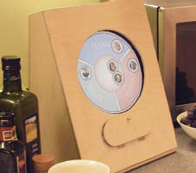
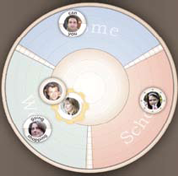
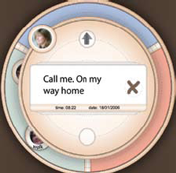
The Whereabouts Clock: the left hand image shows the clock in its case; the middle image is a close-up of its interface; and the right hand image shows what happens when you touch on a text message. (p. 71)
Case Study: The value of augmenting human memory
In what situations might we want to remember and why? And is it sometimes better and more desirable to forget? (p. 73)
Different human values guide us in different directions, both in terms of the literature we need to look at, and the work that needs to be carried out. (p. 74)
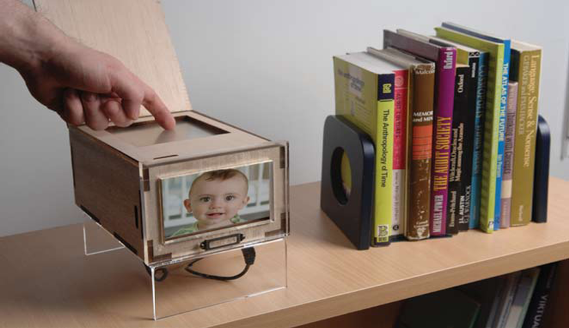
The Digital Shoebox, by designer Richard Banks of Microsoft Research Cambridge UK, is an attempt to make the storage of digital photos more tangible. Photos can be sent wirelessly to the box, and users can browse through them by running their finger across the top of the box. (p. 75)
In the future, more lightweight, rapid prototyping and design iteration processes will be required, ones that will allow complex ecosystem experiences to be investigated as well as simpler, human-machine relationships. (p. 81)
Just as computing has gone beyond the interface, so, too, will HCI professionals need to move outside of the scientific community they have lived within and find ways to engage with society as a whole. (p. 92)
9The IIP CREATE Scientific Research Agenda
The IIP CREATE Scientific Research Agenda was announced on 8 May 2008 during the ICT Delta Congress. The complete report is available from:
http://83.98.156.43/~iipcreate/wp-content/uploads/2008/05/iip_create_book_sra.pdf.
9.1Press release
Below is the Press release from the Waag Blog page
This is the Strategic Research Agenda (SRA) of the ICT Innovation Platform CREATE. IIP/CREATE is the cooperation of the leading Dutch stakeholders in the creative sector from industry, non-profit institutes, SMEs, universities, HBOs and academies, sector platforms and intermediaries. It is supported by ICTRegie. The SRA addresses the growth potential of the creative sector for the Dutch economy, our society and our education and research. It identifies the barriers for further productivity growth and describes measures and instruments to remedy this.
The creative sector that is driven by ICT and Media
Economy growth relies on ideas, skills and quality to excel, on entrepreneurship, on the work force to make it happen and ultimately on society where all these aspects are rooted. We live in an era where the value system of society changes rapidly as a result of the rise of the ‘creating’ class. The ‘creating’ class forms a new economic sector where relative autonomy, creativity, a networked context, and (large-scale) production of small-scale expressions define its work ethos. At the core of the ‘creating’ class addressed in this SRA is Information&Communication Technology and Media. This definition – similar to the one of CPB – covers 30% of the workforce.
The potential of the creative sector is not employed
Dutch design rightfully acquires great fame, yet these results in limited impact in economic or social terms. The principal barrier is one of scaling. We do not employ the economic and societal benefit that this sector has to offer because small scale creatives do not know how to upscale their creative production in NL and large scale industry and the public sector do not know how to adopt creative products or ways of working. The SRA identifies two further barriers for increasing productivity:
Coordination problems that occur when engineers and creatives do not find one another, and when knowledge and information are fragmented. Multidisciplinary projects are a way to remedy this.
Barriers to entry that exist and are mostly due to a lack of real communications.
What is needed are complete ecosystems with science, inspiration, and production insight are combined. The IIP/CREATE is the start of such ecosystem at a national scale and aims to stimulate the economic growth of the sector in the Netherlands by 2 % annually. The potential of the sector is illustrated by experts throughout the SRA with scenarios for 2015 on games, shopping, cultural heritage, public health, hospitality, culture and education, and eGovernment.
Creating ecosystems in the Netherlands
Whereas the rise of the ‘creating’ class occurs world-wide, we focus on the changes in the Netherlands. We have identified trends, strengths, weaknesses, opportunities and threats that are important to create the winning ecosystem in the Netherlands. We must take advantage of innovation models and ways of working suiting the Dutch. Our excellent infrastructure provides an opportunity to invest in content, but at the same time also creates more information for the content providers abroad. Economic benefit of Dutch creativeness is often exploited elsewhere. Therefore, we must invest in Dutch ICM technology and experience labs. Current government instruments need improvement as they do not suit creative research well.
Creative entrepreneurship has been successful as the new way of life for SMEs and ZZPs. However, innovation here is stalling. To complicate matters, classic intellectual property rights are fading away on a global scale, putting pressure on creative business models. The first to experiment with the new IPR wins.
The Netherlands have a good potential advantage. It is our vision to create world-class ecosystems of the creative sector, by creating coherence between knowledge centres, industry and the non-profit leaders in regional contexts. Example ecosystems are presented in Amsterdam, Utrecht, Eindhoven, Rotterdam, and the NIRICT.
The Strategic Agenda
In workshops and interaction with the field, we have identified the most vital themes to develop. Themes with the highest potential of success and a sense of urgency have been coupled with tools for broad support in the field. The five themes are:
8.searching & finding
9.context exploration
10.virtual and real worlds
11.collaboration as a way of life and
12.interactive and tangible environments.
To stimulate progress in these development themes, nine tools are discussed. These are instruments for interaction, location-based infrastructures, tools for data worlds and tools for building real & virtual worlds. Furthermore, the SRA proposes to extend the role of creative sector laboratories such as world experience labs and living labs. Equally important measures such as policies for property rights, entrepreneurship of the creatives, and research of the creatives are described. For each theme and each tool we argue why the Netherlands is an excellent place to endorse its development. Per theme and tool also, we indicate immediate stakeholders in the Netherlands.
Creating a winning ecosystem The SRA proposes a mix of long-term research with short term demonstrations and high-profile applications, consequently to form new chains of knowledge for an enduring advantage. The two cornerstones for getting there are:
Creating champions: by implementing a focus, by building new chains, and by investing in multi-disciplinarity
Providing Instruments and Incentives: Financial, Organizational, Facilities, room for R&D, dedicated education and coordination.
We focus on the ‘hottest’ spots supporting local initiatives, wherever they originate. We aim to introduce vouchers for the production of creative ideas, for creative pioneers, and vouchers for the production industry and coaching. For the restoration of chains, we aim to build large-scale programs and new reward systems. For community building, we suggest public awareness programs, registration of best practices, and the maintenance of open-source technological sources. We suggest a few programs on education. We suggest a PhD on the basis of a work of art and on the basis of a start-up company. And, we aim to develop a program for stipends to artists, and for public broadcasting to be a lead customer.
The SRA instruments and tools are geared to exploit the EU ambitions, which proposes 2009 as the Year of Creativity and Innovation.
9.2The Strategic Agenda Revisited – implications for Creative Technology
We have chosen, in addition to the text of the press release, to represent the main tenets of this excellent, and extremely timely report, not because we could not think of the wording ourselves, but because we feel that a verbatim paraphrase allows us to find support in an authorative voice, expressing opinions that have far wider resonance than the working group for the creative technology bachelor would ever be able to obtain. Nevertheless, we have included our opinions so as to emphasize our point of view and indicate our particular strengths, where we aim to create a, as it is called in the report, local eco-system for creative technology, at a university that carries both convergence of technologies with societal impact and creative entrepreneurships as their mission towards the Dutch and local society.
From the managements summary we may read as a characterization of the creative sector:
The creative sector: Economic growth relies on ideas, skills, and quality to excel, on the work force to make it happen and ultimately on society where all these aspects are rooted. (p. 6)
With respect to the economic potential the report is careful:
The potential: Estimation of the economic perspective in standard ways is hard as data about this new sector lag behind. Nevertheless, there is ample evidence of a considerable impact in times where technology becomes invisible, hardware is cheap and content becomes invaluable.
Nevertheless, it leaves no doubt about the impact of these developments, especially in a social context:
Socially, the rise of the creating class has an enormous impact on the participation in (virtual) communities, to restore coherence, narrowing the digital divide, and introducing new ways of living in the city.
And to emphasize, as later also more explicitly indicated in the report, the creative industry is regarded a necessary factor to remedy the potential dangers of the rapid technical developments to our society:
The impact of the creating industry is inevitable, desperately needed to balance the excitement of internet and games at home.
And this holds, not surprisingly also for the Dutch situation:
In the Netherlands: The life style of consumers will be creative and personalized, supplied with mass produced individual expression.
In particular, as observed in the report, broadband is widely available; nevertheless there is a tendency for the creative industry to gather in particular centres of our country, since:
Where broadband introduces the whole world in the living room, proximity will paradoxically gain in importance.
The committee writing the report has set itself as a goal:
In science and technology there is an apparent lack of a coherent agenda, as opposed to foreign countries which invest heavily in this field.
It is our vision to create world-class eco-systems of the creative sector, by creating coherence between knowledge centres, industry and non-profit leaders in regional contexts.
It is instructive, from our point of view to read what the report mentions as examples of areas which acts as centres of creative industry:
Examples: Amsterdam, Utrecht, Eindhoven and Rotterdam. (p. 7)
And indeed, why not Twente, you may ask. Here we may state, not needing any further argumentation, that Twente should make effort to be also in the list, since it satisfies many of the necessary conditions, that is the occurrence of (education in) science, arts and a lively entrepreneurial climate. Our proposal for a bachelor creative technology as explained fully in the main body of our accreditation report, fits seamlessly here, and may acts as a necessary impetus to put Twente on the creative map of the Netherlands.
The strategic agenda of the report mentions five themes:
The five themes are: search & find, contextivity about the context of context exploration, virtual and real worlds, collaboration as a way of life, and interactive and tangible environments. (p. 7)
In each of these themes our curriculum has to a greater or lesser extent an offer. And here we emphasize that, as much as possible, we would like to approach these themes from a unified vision that is found suitable interactions between these themes, whenever possible.
The report spends ample deliberation on what it considers conditions for creating a winning eco-system:
This agenda proposes a mix of long-term research with short-term demonstrators and high-profile applications, consequently to form new chains of knowledge for an enduring advantage.
We focus on the hottest spots, supporting local initiatives, wherever they originate.
In other words, local context and imitative are determining success factors, and as such it from our point of view more a matter of whether the UT has the courage to take this initiative, than whether the necessary conditions are satisfied, which to our mind leaves no room for doubt.
Despite the visionary rhetoric used in the report, as some may regard it, the report gives in our opinion a very accurate description of the current cultural and academic landscape, as it concerns the creative industry. It is worth emphasizing that a large, representative group of people have been involved in the writing of it:
IIP/CREATE: The Strategic Agenda was produced by the program board of IIP/Create and created in discussion with industry, non-profit institutions, SMEs, universities, HBOs and academies, platforms and intermediaries, and supported by ICTRegie.
Apart from the grand overview given in the managements summary, it is worthwhile to look in some more detail at the observations made in the report, in particular as they pertain to education and our target audience, that is essentially members of what the report calls the creative class:
Living the creative way: Millions of people are beginning to work and live the creative way, as artists, consultants and scientists always have done. (p. 10)
The creating class: Our definition of the creating class covers the creation and recreation of products; it contains experience and information, media and their impact. In short, it contains all who are creating in relative autonomy, operate in a social network, live in a local eco-system and deliver their goods wherever they are in the world.
It is interesting to note that the report has a wider definition of the creative class, which includes for example also scientists (!), than the CPB, which puts stronger emphasis on the relation with the arts and human experience:
Cf. definition of CPB, which is narrower: The creative industry is a specific form of industry, which produces products and services which are the result of individual or collaborative behaviour and entrepreneurship. Content and symbolism are the most important elements of these products and services. They are purchased by consumers because they evoke meaning. On this basis experience is created.
Irrespective of what definition is adhered to, both research and education for the creative industry is inherently multi-disciplinary:
Essential parties: Our target lies at the crossroads of three parties. We need inspiration and content from the arts, from cultural heritage, from design. And we need industry to make and sell it. And we need science and innovative ways of thinking to make the product or service ... (p. 11)
In other words,
we need content designed with a touch of excellence and empowered by science.
As critical success factors, the report mentions:
Technology, talent and tolerance: Extensive research shows that successful eco-systems, with respect to innovation and growth, have three factors in common: technology, talent and tolerance.
Especially, while positioning our curriculum creative technology in an academic/engineering environment it is worthwhile to keep in mind, as the report phrases it:
A tolerant environment attracts top creative and top creating talents. (p. 11)
There should be no need to divulge into the potential of investing in (education for) the creative industry:
The potential: Dutch creativity is world famous, but does not (sufficiently) payoff economically. (p. 18)
Cultural potential: New technology is first applied in the old idioms, later it is employed in line with its own capabilities. As a consequence, the many ways in which ICT technology will innovate the arts are still to be discovered.
And let's be clear, there is not only cultural potential, but economic potential as well, simple because learning becomes essential for our total workforce:
Potential in learning: learning at school and life long learning. (p. 31)
The report, moreover, clearly states what education for the creative industry entails:
Education for the creative industry: It is essential that education at schools, universities, and in programs aimed at people in the creative industry adjust to the developments we have sketched.
And, again no need to emphasize, our curriculum creative technology must be seen as instrumental in conveying both skills and competences in an appropriate way:
The new possibilities, technologies and applications must find their way to the (future) creative work force.
Current arts programs at academies should include more training of technical skills and technical schools should give more attention to the development of people with creative skills.
The report makes some interesting observations about creative entrepreneurship, and how media artists might be looked at as role models:
The role of the media artist: The rise of the media has only just begun. Today's and tomorrow's interactive media applications represent a significant part if the creative industry, where co-creation and meaning become crucial. Interactive art and design have created a valuable expertise and a rich practice in relevant fields of human or user-centred and participatory design. (p. 44)
Equally interesting is the importance the report attaches to regionality or regional eco-systems:
Open or collaborative across-discipline innovation in a local eco-system is a winner. (p. 44)
The vision: We need the creatives for their contributions to realize the necessary transitions in society and education. (p. 46)
It is our vision to create a world-class eco-system of the creative sector, by creating coherence between knowledge centres and the non-profit leaders in regional contexts.
And, again creating education for the creative industry is not something that should be done in isolation. Also for our curriculum creative technology in addition to the great variety of expertise in-house, we essentially need to cooperate with the partners in the local context, including Saxon, Syntens, and de creatieve fabriek:
Collaboration is a way of life: Cooperation improves creativity, breeds industrial and cultural innovation and transcends fixed patterns and structures. (p. 47)
Evidently, from an educational perspective, we need the courage to look beyond the traditional boundaries of engineering and computer science.
The report makes also in very clear wording explicit how creative research differs from traditional academic research:
Research of the creatives: Creative research is totally different from academic research, the techniques, the process, the results and the way these are appreciated. (p. 61)
And, again, the reports refers to the media artist as a role model:
The contemporary media artist is a researcher, designer and mediator who is positioned in the centre of disciplines and patches together knowledge fields and methods.
The message is simple and clear:
Academic and creative research is destined to go hand-in-hand to learn and benefit.
In the local situation, that is the Netherlands, the report observes:
In the Netherlands,..., we have many yet isolated examples of successful cooperation between creative and scientific research ...
We should keep in mind, according to the report:
Creating coherence is a key issue. (p. 63)
This directly points to the relevance of (proper) education:
Cornerstones: education for a world-class knowledge and creativity to feed into the eco-systems. (p. 67)
The timeliness of the report, as well we hasten to add, the proposal for our bachelor creative technology is testified by the (in itself incidental) occurrence of the fact that the UE has announced:
EU 2009: The year of Creativity and Innovation
The report concludes on that basis that:
We are to develop outstanding education programs, combining technology, research, business and design & art. (p. 69)
Since, as the report states:
Only if young people see career opportunities the knowledge chain can be closed again.
More in detail, the report proposes:
Education and permanent learning (p. 71):
•Master programs will be developed allowing students to enhance their knowledge and experience in other directions, like a master for creative service design.
•In addition, we endorse collaboration between ICT and art colleges in the form of exchange of staff and students.
We wish to go a step further and start with a bachelor, to prime young people, with fresh minds. If not integrated from the start, the Dutch bureaucratic university and school systems might prevent such exchange to happen, even if only due to the perception of students that just come from high school, and still need to find orientation in their lives.
In conclusion, in the iip/create report, we find, so to speak, the evidence that our initiative to create a bachelor creative technology is not only timely, but also well-focussed, both in terms of content, as it deals with many of the issues relevant for the future work force of the creative industry, and in regional approach where it is meant to strengthen the creative industry in the eastern part of the country, in close cooperation with a wide range of potential partners, supported, where needed, with what in Dutch may be called some grootstedelijk elan.
10Resources
10.1Background material
[Facets06] -- FACETS OF FUN -- On the Design of Computer Augmented Entertainment Artifacts, Sus Lundgren, Department of Computer Science and Engineering, Chalmers University of Technology and Göteborg University, 2006, available at:http://www.cs.chalmers.se/%7Elundsus/lundgren_facets_of_fun.pdf
[Human08] -- BEING HUMAN HUMAN-COMPUTER INTERACTION IN THE YEAR 2020
Edited by Richard Harper, Tom Rodden, Yvonne Rogers and Abigail Sellen
is available from: http://research.microsoft.com/hci2020 (see Part C.8)
[IIP/CREATE] -- ICT Innovation Platform -- Creative Industry, presented at ICTDelta, 8 may 2008, Utrecht, available from: http://iipcreate.nl , press release at http://iipcreate.waag.org, (see Part C.9 and Part D)
[LEONARDO] -- Leonardo Book Series, MIT Press, http://mitpress.mit.edu/catalog/browse/browse.asp?btype=6&serid=4
Envisioned as a catalyst for enterprise, research, and creative and scholarly experimentation, the Leonardo book series enables diverse intellectual communities to explore common grounds of expertise. The series publishes texts by artists, scientists, researchers, and scholars that present innovative discourse on the convergence of art, science, and technology. It provides a context for the discussion of contemporary practice, ideas, and frameworks in the rapidly-evolving arena where art and science connect.
[NEWCOM06] -- UT BRANDING - Extern onderzoek onder 4, 5 en 6 vwo’ers, NEWCOM, 2006.
[NEWCOM07] -- CREATE Onderzoek naar marktpotentieel, NEWCOM, 2007.
[TNO05] -- P. Rutten, T. IJdens, D. Jacobs, K. Koch: Knelpunten in creatieve productie: creatieve industrie – TNO Report 2005.
10.2Online references
10.2.1Learning material and tutorials
There is a great number of tutorials and information sources online, a small (non-representative) selection is given here, merely to illustrate the variety of these resources:
-lindenmayer systems -- http://www.biologie.uni-hamburg.de/b-online/e28_3/lsys.html
-web technology -- http://www.w3schools.com
-Google labs -- http://labs.google.com
-media theory -- http://networkcultures.org/wpmu/krant
10.2.2Inspiring examples of media art
There are too many examples that may provide an inspiration, one way or another, to mention or even categorize. Again, a non-representative selection is given:
-early web art -- http://wwwwwwwww.jodi.org
-digital art -- http://www.digt-paint.nl/digital_view
-local festival(s) -- http://www.planetart.nl/
-information art -- http://www.wefeelfine.org
10.2.3Resources for smart systems
There are ample resources describing technology and projects that somehow mix smart technology and new media. These include:
-sensor technology -- http://www.phidgets.com
-magic lenses -- http://www.deutsche-telekom-laboratories.de/~rohs/wikeye
-interactive spaces -- http://roomwareproject.org
-intelligent displays -- http://idisplays.info
10.2.4Events, creative business, research and technology
Here we list some examples of (past and upcoming) events that are, one way or another, related to creative technology.
-Gaming & New Literacy 2008 -- http://www.ugame-ulearn.com/nl
-ICTDelta 2008 -- http://www.ictdelta.nu/programma
-CTIT 2008 (UT) -- http://www.ctit.utwente.nl/ctit_symposium_2008
-PICNIC 2008 (Westergasfabriek, Amsterdam) -- http://www.picnicnetwork.org
10.2.5Institutions and sources of information
A number of institutions proves well-structured repositories of information, that may be used in our courses, or advised as background material for students doing projects.
-New Media Consortium -- http://www.nmc.org/publications
-MIT Open Course Ware -- http://ocw.mit.edu/OcwWeb
-HCI Resources -- http://www.hcibib.org
